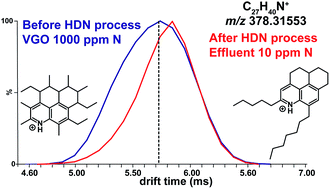Accueil du site > Production scientifique > Structural analysis of heavy oil fractions after hydrodenitrogenation by high-resolution tandem mass spectrometry and ion mobility spectrometry
Structural analysis of heavy oil fractions after hydrodenitrogenation by high-resolution tandem mass spectrometry and ion mobility spectrometry
Date de publication: 11 janvier 2019
Johann Le Maître, Marie Hubert-Roux, Benoît Paupy, Sabrina Marceau, Christopher P. Rüger, Carlos Afonso, Pierre Giusti
Faraday Discuss. 218 417 (2019). DOI
Travail réalisé sur le site de l’Université de Rouen.
Abstract

Heavy petroleum fractions such as vacuum gas oils (VGOs) are structurally and compositionally highly complex mixtures. Nitrogen species, which have a significant impact on the subsequent refining processes, are generally removed by the hydrodenitrogenation (HDN) catalytic process. The purpose of this study was to identify and characterize compounds that are refractory to the HDN process. This may allow for the examination of the effectiveness of a vacuum distillate hydrotreatment catalytic bed in removing nitrogen-containing compounds before the cracking step. Three different VGO fractions of the same oil before and after HDN processes were analysed in ESI(+) mode by FTICR mass spectrometry and ion mobility spectrometry–mass spectrometry (IMS-MS), in particular compounds containing basic nitrogen, such as quinoline and isoquinoline. Ultra-high-resolution FTICR mass spectrometry provides a sufficiently high mass resolution power to resolve different compounds and attribute a unique molecular formula to each ion. Information on the isomeric content was obtained by use of tandem mass spectrometry (MS/MS) and IMS-MS. The evolution of the fragmentation of the N1 class of compounds as a function of collision energy allowed for the identification of the molecular nucleus raw formula. From the IMS-MS experiments, it clearly appeared that, based on the IMS peak width, a lower isomeric dispersity was obtained after the HDN process and, based on the drift time and collision cross section determination, species presenting longer alkyl branches are the molecules most refractory to the HDN process.








